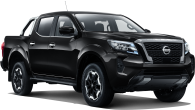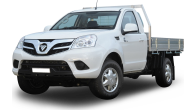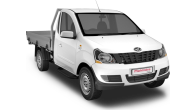If there was a feeling at Stuttgart that any vehicle displaying a three-pointed star could do no wrong, the X-Class should be a wake-up call. It's a vehicle that appears to have drawn a line in the sand in terms of what people are prepared to accept as an authentic Mercedes-Benz.
Sure, the fastest and cheapest way into the booming dual-cab ute segment was to piggy-back an existing player, in this case the D23 Nissan Navara, as M-B has a tech-share agreement with the huge Nissan-Renault-Mitsubishi alliance. The Navara/X-Class relationship is similar to Ford Ranger/Mazda BT-50 or Isuzu D-Max/Holden Colorado.
But we are talking Mercedes-Benz here. Given the high esteem in which the German marque is held and its pre-eminent off-road heritage, with icons like the Unimog and G-Wagen, the end result has fallen short of understandably high expectations. It's even built in a Nissan plant. Put simply, it over-promised and under-delivered.
However, are perceptions of the X-Class being a rush job or little more than a badge-engineered Navara fair or accurate? We recently put the work-focused entry-level X-Class to work in our search for answers.
Mercedes-Benz X220 2018: D Pure (2Wd)
| Engine Type | Diesel Turbo 4, 2.3L |
|---|---|
| Fuel Type | Diesel |
| Fuel Efficiency | 7.6L/100km (combined) |
| Seating | 5 |
| Price From | $22,770 - $28,160 |
| Safety Rating |
|
Does it represent good value for the price? What features does it come with?
Our test vehicle is as basic as an X-Class can get - the X220d Pure 4x2 dual-cab with six-speed manual transmission for $46,400. It's effectively a 'Hi-Rider' in industry speak, even if M-B doesn't use that term.
Given its work-focused specification, with hose-out vinyl floor, 17-inch steel wheels with 255/65 R17 road-biased tyres and matching spare, plus black bumpers, door handles, hub caps, etc, with not a hint of bling anywhere (bar the shiny three-pointed star on the grille), pricing north of $46K (before on-road costs) is Pikes Peak steep compared to the competition.
For example, the Ford Ranger Hi-Rider 4x2 in base-level XL trim with 2.2-litre diesel and six-speed manual is only $36,390 and Toyota's HiLux Workmate 4x2 Hi-Rider with 2.4-litre diesel and six-speed auto is $39,490.
.JPG)
And keep in mind our test vehicle also has the $1300 'Plus Package' ('Parktronic' and adjustable load-securing rail system), optional 1-DIN audio access ports ($150) and rear window guard frame ($490), raising the price to $48,340. That's a lot of money for a new player to be asking at base level, regardless of how much its star may twinkle.
Even so, the X220d's standard equipment list does include useful stuff like front fog lamps, DRL and dusk-sensing head lights, cruise control, tyre pressure monitoring, rear view camera, four 12-volt sockets, load tub light, four-speaker audio system with big 7.0-inch screen, multiple connectivity including Bluetooth and steering wheel controls, plus benchmark safety.
Is there anything interesting about its design?
Benz has re-engineered the Navara's steel ladder-frame chassis for greater rigidity and topped it with a restyled body that's 85mm longer and 126mm wider with a new M-B interior. There are also new front suspension components and a new coil-spring multi-link live rear axle assembly with disc brakes, which result in track width increases of 82mm front and 75mm rear (compared to RX Navara 4x2).
These engineering changes, combined with revised springs, shocks, anti-sway bars and steering, result in sure-footed handling with sharp steering response, excellent ride quality and a feeling of solidity that are all X-Class strengths. However, they have also resulted in a hefty 236kg weight gain.
The X-Class Pure 4x2 rides on a 3150mm wheelbase with a 5340mm overall length, 1916mm width and 1839mm height. In comparison to Ford's Ranger, which is considered the 'bigfoot' of Aussie dual cabs, the X-Class is 70mm shorter in wheelbase and 22mm shorter overall, but 56mm wider, 24mm taller and lineball on turning circle at 12.8 metres. So, like the Ranger it's quite a large and imposing vehicle.
.JPG)
Critical rough road credentials include 222mm of ground clearance with 30 degree approach and 25 degree departure angles. Its wading depth of 600mm is better than Amarok (500mm) but considerably less than Ranger (800mm).
It's nice to see sizeable grab handles on the window pillars for front and rear passengers and the driving position is pretty good. However, the Pure's front seats lack sufficient lumbar support and the base cushion (at least the driver's) needs some rake adjustment, as it can feel like you're sliding off the front at times.
For such a sizable vehicle we're surprised by how cramped the rear seating is for taller adults in terms of length and height, with knees touching the front seat backrests and, thanks to the higher 'grandstand' style rear seating, heads touching the roof lining. The rearward location of the B pillar also makes for quite tight entry and exit for those long of limb and large of shoe.
What are the key stats for the engine and transmission?
The X-Class shares the Navara's engines and transmissions, but Nissan's superb YS23DDTT 2.3 diesel with sequential twin turbocharging and 140kW/450Nm is reserved only for the X250d variants.
The entry-level X220d Pure 4x2 and 4x4 models (like the entry-level Navara RX) make do with the less powerful but still excellent single turbo version with variable vane technology, producing 120kW at 3750rpm and 403Nm of torque between 1500-2500rpm.
The RWD Pure's six-speed manual gearbox (backed by hill start assist) has a pretty low (4.685:1) first gear which is handy for getting big loads underway from standing starts, while the over-driven top gear allows economic engine rpm at highway speeds. There's no rear diff lock like the Ranger Hi-Rider.
.JPG)
How much fuel does it consume?
Mercedes Benz's official combined figure is 7.6L/100km and the instrument display was showing that figure at the end of our test, which covered more than 660km on different roads (sealed and unsealed) and with a variety of loads, including our usual GVM run.
By comparison, our figures calculated from trip meter and fuel bowser readings came in at 9.0L/100km. Any dual-cab ute, particularly one this size, which can deliver genuine single-digit fuel economy in 'real world' driving gets a big tick from us. Based on our figures, you could expect a realistic driving range of 850km-plus from its 80-litre tank, which is fuel efficiency with a capital E.
How practical is the space inside?
Deducting the 4x2 Pure's 2046kg kerb weight from its 3200kg GVM would normally equal a payload of 1154kg, but the official payload figure is 68kg under that at 1086kg, which is an extra safety margin should the payload (but not the GVM) be exceeded.
The Pure 4x2's braked towing capacity of up to 3200kg is less than the 4x4 models' 3500kg rating. Even so, its generous 6139kg GCM allows for a substantial 884kg payload while towing its heaviest trailer load, which is impressive.
The load tub is 1581mm long, 1560mm wide and 475mm deep, with 1215mm between the wheel arches ensuring it can carry an 1160mm-square standard Aussie pallet. As mentioned earlier, our test vehicle was equipped with the optional $490 rear window guard frame, which should not only be standard but also have tradie-friendly pivoting load retainers or 'book-ends' on each side for carrying long lengths of timber, PVC pipe, etc.
The test vehicle's adjustable load-securing rail system mounted near the top of the tub (as seen on Navara) works well for securing loads of matching height or more, but there also needs to be four tie-down points in each corner at floor level to secure lower loads as well. The absence of load retainers and floor level tie-down points are glaring omissions for such a work-focused vehicle.
With tradies in mind there's also a lack of cabin storage, limited to bottle holders and storage pockets in each front door, an overhead sunglasses holder and small glove box. The multimedia system's sizeable rotary controller and touch-pad occupy a big chunk of potential storage space in the centre console, which only offers a tiny front storage slot, single cup holder and small rear lidded box (and there's no box if you opt for the 1-DIN audio ports as fitted to our test vehicle).
Rear seat passengers get a bottle holder and smaller storage pocket in each door and the bench seat base pivots upwards to a vertical position if you want some extra internal cargo space. But there are no flexible storage pockets on the front seat backrests and no cupholders. This needs a re-think because you quickly run out of places to store things.
What's it like to drive?
It might be based on a Nissan Navara, but it doesn't drive like one. Even at 4x2 entry level, the X Class's excellent un-laden ride quality, sure-footed 'wide track' handling and steering feel/response are benchmark for the class, which is the minimum you'd expect from this brand. Cabin noise is also low.
The single-turbo Nissan engine is a strong point. Despite the X-Class having a higher kerb weight, the Navara engine does not feel sluggish, with ample low and mid-range punch making it a spirited enough performer under light loads with more than enough torque for heavy load-hauling. The six-speed manual gearbox shifts sweetly and its ratios are well matched, keeping the engine in its maximum torque band on the highway with 2000rpm at 100km/h and 2300rpm at 110km/h.
.JPG)
To test the 3200kg GVM rating we forklifted 920kg into the load tub, which with a 100kg driver was only about 60kg under its 1086kg payload ceiling. The rear coil springs compressed a full 80mm and the nose rose 21mm, resulting in the rather ungainly tail-down-nose-up 'praying mantis' stance similar to the coil-sprung Navara from which it is derived.
A look under the tail revealed the top of the rubber bump-stop cones just kissing the underside of the chassis rails. Once underway, though, there was none of the Navara's riding-on-rubber feeling, as the Merc's thicker rising-rate rear coils maintained a modicum of springing. However, the sloping tail felt less stable, with some noticeable suspension squirm in a straight line and wagging through some corners, particularly on unsealed roads.
Even so, its Nissan engine made light work of our 2.0km 13 per cent gradient set climb, proving its excellent load-lugging ability by climbing it so easily in third gear that we made a second successful ascent in fourth. Engine braking in second gear on the way down, though, could not restrain such a big payload on its own, requiring regular prods of the brake pedal to maintain the 60km/h limit.
Warranty & Safety Rating
What safety equipment is fitted? What safety rating?
Maximum five-star ANCAP rating and first dual-cab ute to bring AEB to this segment gets a rare perfect score from us. Passive safety includes driver and front passenger front, thorax, side curtain and driver's knee airbags, child restraint top tethers plus iSize and ISOFIX anchorages on outer rear seat positions.
Active safety also includes lane-keeping assist and vital ute features like brake-force distribution, trailer stability assist, hill start assist and tyre pressure monitoring.
What does it cost to own? What warranty is offered?
Warranty cover is three years/unlimited km with 24/7 roadside assist.
Service intervals are 12 months/20,000km, whichever occurs first. Under M-B's 'Service Care Promise' the first three scheduled services will cost between $585 and $930.
Verdict
The X-Class Pure 4x2 is good, but that's its major problem, because three-pointed stars and their high price tags bring with them a justified expectation of being not just good - but great. If a second-generation X-Class needs to borrow some components again, we hope they're from the legendary G-Wagen next time. In fact,a platform share between X-Class and G-Wagen (like Ranger/Everest or Colorado/Trailblazer etc) would have much greater appeal.
Does the X-Class Pure 4x2 justify the high price demanded by its prestige badge? Tell us in the comments below.
Range and Specs
| Vehicle | Specs | Price* |
|---|---|---|
| x220 D Pure (2Wd) | 2.3L, Diesel, 6 SPEED MANUAL | $22,770 - $28,160 |
| x220 D Pure (4Matic) | 2.3L, Diesel, 6 SPEED MANUAL | $24,090 - $29,700 |






.jpg)
.jpg)
.JPG)
.JPG)
.JPG)
.JPG)
.JPG)
.JPG)
.JPG)
.JPG)










.jpg)



